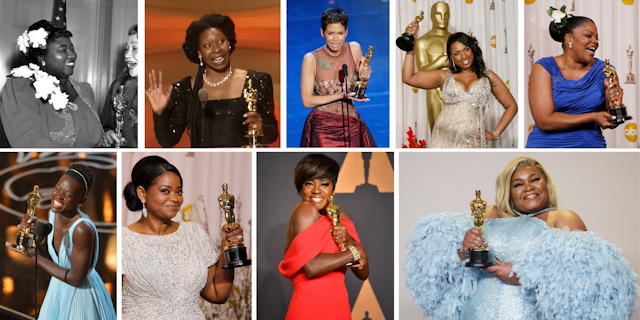On Sunday, nine years after #OscarsSoWhite, millions of us tuned into watch the 96th annual Academy Awards — some to simply take in the spectacle. And some to see how much had changed.
The hashtag #OscarsSoWhite started after many people noticed that, for a second year in a row, all nominees for four of five major categories were white. The movement called on Hollywood to do better: to better reflect America’s demographic realities and also to expand its depiction of our histories.
The reason: representation in Hollywood matters. What gets put on screens and by whom has reverberating impacts on how all of us see each other and see ourselves.
So …. how did the Oscars do this year?
Let’s take a brief look at the evening, which started with the anti-war protests outside the theatre slowing down traffic and delaying the broadcast by a full five minutes.
Although there were only seven racialized actors up for nominations, there were some notable wins in that arena.
Cord Jefferson accepted his award for best adapted screenplay for American Fiction. When at the podium, he talked about how many people passed over the project — a Black film with a primary Black cast. To the producers out there listening, he made a plea to acknowledge and recognize the many talented Black playwrights out there that deserve similar opportunities. He suggested one way would be that producers fund 10 small projects instead of one $200 million dollar film.
Lily Gladstone, though she didn’t win, was the first North American Indigenous woman to be nominated for best actress in its 96-year history.

And Da'Vine Joy Randolph won best supporting actress for her role in The Holdovers, and made a memorable appearance and acceptance speech.
But one night at the Oscars doesn’t paint the full picture.
Just a few months ago, award-winning actor, Taraji P. Henson, broke down in tears in an interview with journalist Gayle King. She was exhausted from breaking glass ceilings as a Black woman in film. “I’m just tired of working so hard being gracious at what I do getting paid a fraction of the cost,” she said. “I’m tired of hearing my sisters say the same thing over and over.”

Henson explained that in 2008’s The Curious Case of Benjamin Button, she was paid significantly less than her co-stars despite having third billing on the call sheet. Henson nearly turned down her role in The Colour Purple for similar reasons.
The pay disparity for Black and Indigenous women in comparison to white women in Hollywood is nothing new.
Here in Canada, the problem is just as pervasive.

Despite some recent wins, a report from Telefilm Canada revealed that Black women have the least representation in TV and film.
They also lead the fewest projects and receive the least funding overall.
To shed some light on the issue, we spoke to two women well versed on the challenges of Black, Indigenous and other women of colour in film and TV.
Naila Keleta-Mae, a playright, poet and singer as well as the Canada Research Chair in Race, Gender and Performance and associate professor of communication arts at the University of Waterloo said that while we need more voices at the table, Black female artists have not been waiting for scraps:
“We have been making the work all this time and will continue to regardless. While we insist on eating at the table, we will also simultaneously continue to nourish and feast on what we’ve been doing.”
We also spoke with actor and director Mariah Inger, the chair of ACTRA National’s Diversity, Equity, Inclusion & Belonging Committee.
Inger warned us to remember that the Oscars represent only one per cent of those working in the industry. And that while many working actors, writers, directors may look to the Oscars as a dream, the reality is that they show up every day because this is where they feel most called to contribute to the world. And she says, in that everyday world, things are shifting.
Listen and follow
You can listen to or follow Don’t Call Me Resilient on Apple Podcasts, Spotify, YouTube or wherever you listen to your favourite podcasts. Full but unedited transcripts are available within seven days of publication.
We’d love to hear from you, including any ideas for future episodes.
Join the Conversation on Instagram, X, LinkedIn and TikTok and use #DontCallMeResilient.

